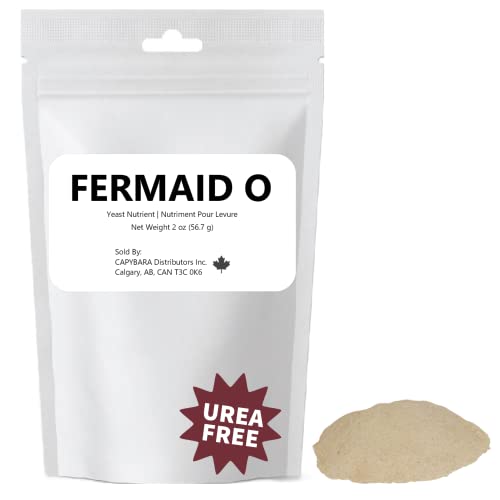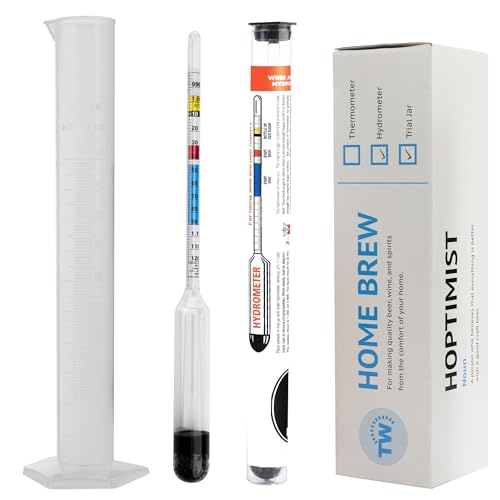I have read a couple of books and scoured this forum and the net and have condensed some information into some notes for myself as a quick reference guide,
If anyone would have a look and see if any areas need addressing I would greatly appreciate it.
Ta
Ian
Here are my notes.....
A week before brewing use Mr Maltys pitching calculator to work out if a starter is required.
MASH
Heat strike water to between 75°C and 80°C
Mash between 62°C -70°C
Water to grain ratio - For Ale use between 2.75L/kg(Thick mash) to 4.4L/kg - the thinner mash results in higher efficiency. Lager use 5L/Kg.
TO make a highly fermentable wort and have drier beer -
Mash at 62°C (needs to be the temp which favours beta amylase)
Mashing for a longer time eg overnight
Do a step mash starting at a low temp then raising higher.
TO make a less fermentable, sweeter wort with more body -
Mash at 70°C.
Add more crystal malt or cara-pils which produces more unfermentable dextrins
If playing about with water treatment check mash pH with papers
Mash at too low a temp and the alpha amylase won't kick in properly
Don't aerate the grist. just stir well.
Leave in mash tun/cooler for between 60 - 90-mins (Check for complete conversion after 60 mins by taking a sample of the wort and putting it on a clean white plate and adding a drop of iodophor. If the sample turns purple/black then there are starches present and the mash should be continued. Make sure the plate is spotlessly clean, any food residue can also cause the iodine to change colour.
Add hot water if goes below 62°C.
Add some boiling water to the mash to raise the temperature to 75°C for 15 minutes and perform a "Mash Out" to increase efficiency
Add FWH (30% of finishing hops) to boiler just before sparging.
BATCH SPARGE (About 72% efficiency) Heat sparge water to 75°C. Place holey foil over mash to maintain filter bed when sparging. Recirculate 1st runnings (about 2 litres)until clear. Drain full tun slowly into boiling pan no splashing, siphon tube needs to be submerged asap. Fill back up gently at 1st then fill tun with rest of sparge water. Leave 10 mins. Recirculate again and slowly drain as before. Wort is now ready for the boil.
OR
FLY SPARGE
Heat sparge water to 75°C. Recirculate 1st runnings (about 2 litres)until clear. Adjust HLT tap so that its a trickle ( one gallon in 15 mins) - fly sparging should take between half an hour to 2 hours! Ensure an inch of wort remains above the grain bed. The sparge water is slowly added as the wort is drained. Stop when gravity of runnings is less than 1.008 or enough wort is collected. A stuck sparge can result from runoff being too fast
BOIL wort. schedule -
90 add bittering hops. stir in well.
15 put immersion chiller in pot to sterilise
15 Add WHIRFLOC tablet
15 Add flavour hops (10-30% of total hops)
0 Flameout, add aroma hops when cooled to 80C (10-15% of total hops)
After the boil, use immersion chiller to cool the wort to yeast pitching temperature as quickly as possible, 20 - 30 mins.
When it has settled out,(15mins) v slowly (results in much clearer wort) pour wort from a height into FV to AEREATE!
Re-hydrating Dry Yeast
rehydrate packet yeast in about 25mL cool boiled water,
stir it after 20-30 mins leave it for a bit more then pitch.
I usually pitch it into wort which is 22-25 then let the temperature drop to roughly room temperature 20ish.
ALE FERMENTATION
Start temp low then increase towards end.??????????
After 24 hrs give another good aeration by shaking vigorously, especially when brewing a high gravity beer.
Skim all the dark brown bitter hop resins and bad compounds off the top of the foam on days1to3.
Primary for 8 days at 21° C , then add dry hops in a vodka soaked muslim bag.
Secondary for 10 days at 18° C.
Condition in fridge for 5 days at 3°C
FINING
Whirfloc 10 mins before flameout.
After secondary fermentation chill beer in fridge to 3C (2 days) then;
Add 5 â 10gms polyclar (23L batch) to half a cup of freshly boiled water. (For maximum efficiency the polyclar slurry should be stirred for minimum 15 minutes, preferably 60 minutes & kept agitated until used)
Add slurry to cold conditioning beer. (The colder the beer the better).Gently stir in to the beer then
2 hrs later rack to 2ndary and immediately use auxillary finings.
Auxillary finings(reduces the chill haze) - add to secondary fermenter and leave 2-3 days.
Transfer to keg which already has Isinglass(reduces yeast) at the bottom of it.
Leave 3 days in the keg at 3C
Chill beer in fridge (this is most important and makes a massive difference).
KEGGING
Keg the flat beer, purge with CO2 and put 5-10 psi into keg to help seal the lid and poppets, this small amount of co2 wont effect maturation in anyway.
Co2 can hinder the conditioning process and as carbonation only takes a week it's probably worth waiting until a week before you intend to drink before switching the gas on.
AGE FOR 1 week per 10 points of OG ie age a 1.050 beer for 5 weeks
LAGER
For a sg1.040 lager (needs 170 billion yeast cells), pitch 2 sachets dried yeast or 1 smack pack into a 1L starter (also at 1.040).
For a sg1.065-1.075 lager needing 225 -285 billion cells, use same yeast into a 3L starter.
LAGER FERMENT at 7-12°C (45-55°F). Skim all the bitter hop resins and bad compounds off the top of the foam on days1to3. Check gravity after 3 days, if sticking above 1016 or going slow give a gentle stir or add pack of dry beer enzyme (if really necessary). When bubbles change from v fast to slower ( 3/4 way to terminal velocity) its time to do a diacetal rest.
DIACETAL REST - Raise temp to 18C for 2 days then rack into secondary. Cool to lagering temp at 3C (manually altering the temp controller) per day till at 2C.
LAGERING for 5 weeks
The yeast is then allowed to undergo secondary fermentation at a lower temperature of 2°C . This is called the lagering phase, and it takes several weeks to several months to finish this process. It is during this second stage that the lager is allowed to clear and to mellow, thereby producing a clean crisp taste. Taste beer during lagering and stop lagering when your palate tells you the beer is ready to bottle.
Budweiser pg 107 of How to Brew. Rice - makes a drier tasting beer like japenese and american lagers. mash with base malt.see page 174 of How to Brew. (Can use dried rice but needs smashing with hammer or ground up and needs seperate cereal mash.)
To Stop Haze in Ale
Keg then mature for 2 weeks, at about 20C
Then put in fridge for 2 weeks
Aeration and splashing/ too much racking causes STALE BEER..
And thats it so far...........
Thanks for looking and if anyone could spot anything I should change please let me know
THANKS
Ian
Keep crystal malt about 4%, any more is too much toffee!
If anyone would have a look and see if any areas need addressing I would greatly appreciate it.
Ta
Ian
Here are my notes.....
A week before brewing use Mr Maltys pitching calculator to work out if a starter is required.
MASH
Heat strike water to between 75°C and 80°C
Mash between 62°C -70°C
Water to grain ratio - For Ale use between 2.75L/kg(Thick mash) to 4.4L/kg - the thinner mash results in higher efficiency. Lager use 5L/Kg.
TO make a highly fermentable wort and have drier beer -
Mash at 62°C (needs to be the temp which favours beta amylase)
Mashing for a longer time eg overnight
Do a step mash starting at a low temp then raising higher.
TO make a less fermentable, sweeter wort with more body -
Mash at 70°C.
Add more crystal malt or cara-pils which produces more unfermentable dextrins
If playing about with water treatment check mash pH with papers
Mash at too low a temp and the alpha amylase won't kick in properly
Don't aerate the grist. just stir well.
Leave in mash tun/cooler for between 60 - 90-mins (Check for complete conversion after 60 mins by taking a sample of the wort and putting it on a clean white plate and adding a drop of iodophor. If the sample turns purple/black then there are starches present and the mash should be continued. Make sure the plate is spotlessly clean, any food residue can also cause the iodine to change colour.
Add hot water if goes below 62°C.
Add some boiling water to the mash to raise the temperature to 75°C for 15 minutes and perform a "Mash Out" to increase efficiency
Add FWH (30% of finishing hops) to boiler just before sparging.
BATCH SPARGE (About 72% efficiency) Heat sparge water to 75°C. Place holey foil over mash to maintain filter bed when sparging. Recirculate 1st runnings (about 2 litres)until clear. Drain full tun slowly into boiling pan no splashing, siphon tube needs to be submerged asap. Fill back up gently at 1st then fill tun with rest of sparge water. Leave 10 mins. Recirculate again and slowly drain as before. Wort is now ready for the boil.
OR
FLY SPARGE
Heat sparge water to 75°C. Recirculate 1st runnings (about 2 litres)until clear. Adjust HLT tap so that its a trickle ( one gallon in 15 mins) - fly sparging should take between half an hour to 2 hours! Ensure an inch of wort remains above the grain bed. The sparge water is slowly added as the wort is drained. Stop when gravity of runnings is less than 1.008 or enough wort is collected. A stuck sparge can result from runoff being too fast
BOIL wort. schedule -
90 add bittering hops. stir in well.
15 put immersion chiller in pot to sterilise
15 Add WHIRFLOC tablet
15 Add flavour hops (10-30% of total hops)
0 Flameout, add aroma hops when cooled to 80C (10-15% of total hops)
After the boil, use immersion chiller to cool the wort to yeast pitching temperature as quickly as possible, 20 - 30 mins.
When it has settled out,(15mins) v slowly (results in much clearer wort) pour wort from a height into FV to AEREATE!
Re-hydrating Dry Yeast
rehydrate packet yeast in about 25mL cool boiled water,
stir it after 20-30 mins leave it for a bit more then pitch.
I usually pitch it into wort which is 22-25 then let the temperature drop to roughly room temperature 20ish.
ALE FERMENTATION
Start temp low then increase towards end.??????????
After 24 hrs give another good aeration by shaking vigorously, especially when brewing a high gravity beer.
Skim all the dark brown bitter hop resins and bad compounds off the top of the foam on days1to3.
Primary for 8 days at 21° C , then add dry hops in a vodka soaked muslim bag.
Secondary for 10 days at 18° C.
Condition in fridge for 5 days at 3°C
FINING
Whirfloc 10 mins before flameout.
After secondary fermentation chill beer in fridge to 3C (2 days) then;
Add 5 â 10gms polyclar (23L batch) to half a cup of freshly boiled water. (For maximum efficiency the polyclar slurry should be stirred for minimum 15 minutes, preferably 60 minutes & kept agitated until used)
Add slurry to cold conditioning beer. (The colder the beer the better).Gently stir in to the beer then
2 hrs later rack to 2ndary and immediately use auxillary finings.
Auxillary finings(reduces the chill haze) - add to secondary fermenter and leave 2-3 days.
Transfer to keg which already has Isinglass(reduces yeast) at the bottom of it.
Leave 3 days in the keg at 3C
Chill beer in fridge (this is most important and makes a massive difference).
KEGGING
Keg the flat beer, purge with CO2 and put 5-10 psi into keg to help seal the lid and poppets, this small amount of co2 wont effect maturation in anyway.
Co2 can hinder the conditioning process and as carbonation only takes a week it's probably worth waiting until a week before you intend to drink before switching the gas on.
AGE FOR 1 week per 10 points of OG ie age a 1.050 beer for 5 weeks
LAGER
For a sg1.040 lager (needs 170 billion yeast cells), pitch 2 sachets dried yeast or 1 smack pack into a 1L starter (also at 1.040).
For a sg1.065-1.075 lager needing 225 -285 billion cells, use same yeast into a 3L starter.
LAGER FERMENT at 7-12°C (45-55°F). Skim all the bitter hop resins and bad compounds off the top of the foam on days1to3. Check gravity after 3 days, if sticking above 1016 or going slow give a gentle stir or add pack of dry beer enzyme (if really necessary). When bubbles change from v fast to slower ( 3/4 way to terminal velocity) its time to do a diacetal rest.
DIACETAL REST - Raise temp to 18C for 2 days then rack into secondary. Cool to lagering temp at 3C (manually altering the temp controller) per day till at 2C.
LAGERING for 5 weeks
The yeast is then allowed to undergo secondary fermentation at a lower temperature of 2°C . This is called the lagering phase, and it takes several weeks to several months to finish this process. It is during this second stage that the lager is allowed to clear and to mellow, thereby producing a clean crisp taste. Taste beer during lagering and stop lagering when your palate tells you the beer is ready to bottle.
Budweiser pg 107 of How to Brew. Rice - makes a drier tasting beer like japenese and american lagers. mash with base malt.see page 174 of How to Brew. (Can use dried rice but needs smashing with hammer or ground up and needs seperate cereal mash.)
To Stop Haze in Ale
Keg then mature for 2 weeks, at about 20C
Then put in fridge for 2 weeks
Aeration and splashing/ too much racking causes STALE BEER..
And thats it so far...........
Thanks for looking and if anyone could spot anything I should change please let me know
THANKS
Ian
Keep crystal malt about 4%, any more is too much toffee!















![BREWING THERMOMETER STICKERS ACCURATELY MONITOR FERMENTING BEER & WINE LIQUID TEMPERATURES 5PCS HOME BREW SPIRITS WINE LCD ADHESIVE [US]](https://m.media-amazon.com/images/I/311DDjo2X3L._SL500_.jpg)


























 :clap:
:clap: